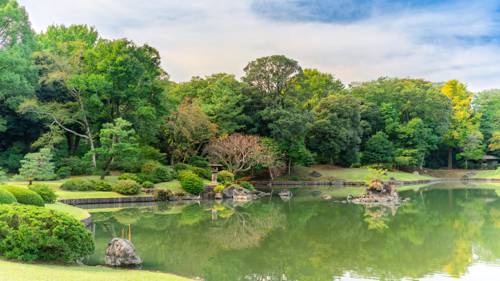
FAQ About The Influence of Japanese Zen Aesthetics in Art and Design

What are the main principles of Japanese Zen aesthetics?
Japanese Zen aesthetics are rooted in principles such as simplicity, naturalness, asymmetry, and tranquility. These elements are closely tied to the Zen Buddhist philosophy, which emphasizes mindfulness and the beauty of imperfection. Simplicity is reflected through minimalistic designs, while naturalness incorporates organic materials and elements. Asymmetry suggests a preference for imperfect forms, celebrating Wabi-Sabi—a concept that finds beauty in imperfection and transience.

How do Zen aesthetics influence modern architecture?
Zen aesthetics have significantly influenced modern architecture by encouraging designs that prioritize minimalism, harmony with nature, and the strategic use of space. Architects often incorporate natural materials like wood and stone, open layouts that promote flow and tranquility, and elements that invite contemplation, such as Zen gardens. This approach results in environments that feel peaceful and connected to their surroundings.

What is Wabi-Sabi, and how does it relate to Zen aesthetics?
Wabi-Sabi is a Japanese aesthetic concept that finds beauty in imperfection and transience. It complements Zen aesthetics by valuing simplicity, irregularity, and uniqueness. This philosophy encourages appreciating the ephemeral and flawed aspects of life. In art and design, Wabi-Sabi manifests through asymmetry, roughness, and natural textures, further emphasizing the balance between nature and intuition.

Can Zen aesthetics be applied to interior design?
Yes, Zen aesthetics are commonly applied in interior design to create serene and harmonious spaces. This approach emphasizes uncluttered environments, use of natural materials, and subtle color palettes. Designers often incorporate elements like bamboo, natural light, and minimalist furniture to promote tranquility and mindfulness. The goal is to develop spaces that offer calmness and reflect the essence of Zen philosophy.

How do Zen gardens reflect Zen aesthetic principles?
Zen gardens, also known as Japanese rock gardens, encapsulate Zen aesthetic principles by featuring simplicity, naturalness, and tranquility. They often include raked sand or gravel, stones, and minimal plant elements to symbolize water and mountains. The beauty lies in their minimalistic design, inviting contemplation and meditation. These gardens are intended to foster a reflective atmosphere and embody Zen values.

Why is asymmetry important in Zen aesthetics?
Asymmetry in Zen aesthetics is vital because it represents the concept of Wabi-Sabi, celebrating the beauty found in imperfection and impermanence. Zen design often favors irregular forms and unexpected compositions that draw the eye and provoke thought. This principle contrasts with traditional Western aesthetics that emphasize symmetry and perfection, highlighting a different perspective on beauty and balance.

How has Zen philosophy influenced contemporary art?
Zen philosophy has deeply influenced contemporary art, leading artists to explore themes of simplicity, mindfulness, and impermanence. Many artists embrace minimalism, use natural materials, and create artworks that encourage reflective observation. The influence of Zen encourages a focus on process over product, valuing calmness and presence over grandiose expressions, shaping a quieter, more introspective art world.

What role does mindfulness play in Zen-inspired design?
Mindfulness plays a crucial role in Zen-inspired design, guiding the creation of spaces and art that promote present-moment awareness and tranquility. By focusing on simplicity and intentional design choices, Zen aesthetics help reduce distractions and foster environments conducive to meditation and contemplation. This approach encourages users to engage deeply with their surroundings, becoming more attuned to subtle details and the natural world.

Can Zen aesthetics be integrated into digital design?
Yes, Zen aesthetics can be effectively integrated into digital design by applying principles such as simplicity and user-focused clarity. Designers can create clean, uncluttered interfaces that prioritize intuitive navigation and harmonious color schemes. Digital zen design often enhances user experience by reducing cognitive overload and promoting a sense of calm, similar to traditional Zen applications in physical spaces.

What is the significance of emptiness in Zen art and design?
Emptiness, or the use of negative space, is significant in Zen art and design as it embodies the principle of simplicity and creates a sense of openness. This space allows for reflection and contemplation, encouraging viewers to appreciate the subtlety of the elements that are present. Emptiness helps balance compositions by making use of silence and pauses, which are integral to the Zen philosophy of finding beauty in simplicity.

How do Zen aesthetics contribute to sustainable design?
Zen aesthetics contribute to sustainable design by emphasizing natural materials, local sourcing, and minimal intervention with the environment. This approach focuses on harmony with nature, reducing waste, and promoting longevity through timeless design. Sustainable Zen practices prioritize quality over quantity, reflecting a deep respect for resources and providing functional designs that withstand trends and time.

What materials are commonly used in Zen-inspired art and design?
Materials commonly used in Zen-inspired art and design include natural options such as wood, stone, bamboo, and linen. These materials reflect the principle of naturalness and help create harmonious environments. Using organic materials supports sustainability while emphasizing texture and warmth, aligning with Zen's focus on simplicity and the appreciation of the inherent beauty found within nature.

How do Zen aesthetics differ from minimalism?
While both Zen aesthetics and minimalism value simplicity, Zen aesthetics encompass broader philosophical elements such as mindfulness, naturalness, and Wabi-Sabi. Minimalism often focuses purely on reducing excess, while Zen aesthetics integrate spiritual dimensions, encouraging balance with nature and celebrating imperfection. Zen-infused minimalism tends to involve a deeper exploration of tranquility and contemplative space.

Are there famous examples of Zen influence in global design?
Yes, there are numerous famous examples of Zen influence in global design, such as the iconic work of architects like Tadao Ando who integrates natural elements and minimalist forms. Zen-inspired gardens, tea rooms, and interiors can be found worldwide, demonstrating the spread of Zen principles such as efficient use of space and harmonious design. These examples reveal how Zen aesthetics transcend cultural boundaries, appealing universally to human instincts for peace and simplicity.

How does color use reflect Zen aesthetics in art and design?
In Zen aesthetics, color use typically involves subtle palettes that reflect natural landscapes and promote tranquility. Earth tones, soft neutrals, and muted colors dominate Zen-inspired designs, invoking a peaceful atmosphere and encouraging contemplation. The restrained use of color ties into the themes of simplicity and mindfulness, avoiding distraction and fostering environments that support meditation and introspection.

What is the relationship between Zen aesthetics and flow in design?
Zen aesthetics and flow in design are interconnected, as Zen principles encourage seamless transitions and harmony within a space. The concept of flow involves creating intuitive pathways and arrangements that enhance movement and ease of use, reducing distractions and fostering a sense of calm. Zen aesthetics prioritize coherence, ensuring that design elements work together harmoniously and support tranquil experiences.

How do Japanese tea ceremonies reflect Zen aesthetics?
Japanese tea ceremonies, or the 'Way of Tea,' reflect Zen aesthetics through their emphasis on simplicity, mindfulness, and ritual. Every aspect, from the choice of utensils to the arrangement of the room, showcases a careful attention to detail and a profound appreciation for the present moment. The ceremony embodies the Zen value of harmonious interactions, providing an immersive experience that is both meditative and aesthetically pleasing.

Can Zen aesthetics influence personal lifestyle choices?
Zen aesthetics can significantly influence personal lifestyle choices by promoting mindfulness, simplicity, and intentional living. Individuals may adopt Zen-inspired practices such as meditation, decluttering, and valuing natural environments, leading to increased tranquility and well-being. Embracing Zen aesthetics encourages living in the moment, finding beauty in daily life, and creating environments that support mental clarity and peace.

What challenges do designers face when integrating Zen aesthetics?
Designers face challenges when integrating Zen aesthetics, such as balancing simplicity with functionality, maintaining harmony with natural elements, and avoiding cultural misinterpretation. Ensuring the principles of Zen are respected and accurately represented can require a deep understanding of the philosophy behind the aesthetics. Designers must carefully navigate these challenges to successfully create spaces and artworks that embody Zen values.

How has modern technology affected the application of Zen aesthetics?
Modern technology has both guided and complicated the application of Zen aesthetics. Technological advancements allow for innovative designs that respect Zen principles, such as sustainable material sourcing and energy-efficient systems. However, the constant connection to digital environments can challenge Zen's focus on mindfulness and simplicity. Designers strive to create technology-integrated spaces that encourage peace and reduce digital clutter.
